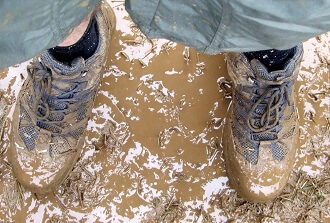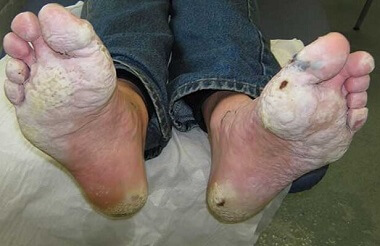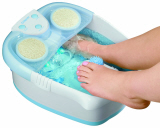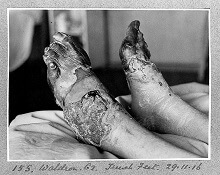Trench Foot
Trench Foot is caused by prolonged exposure to damp, cold, unsanitary conditions. The foot becomes numb, changes color swells, and starts to smell due to damage to the skin, blood vessels, and nerves in the feet.
Trench foot was first recorded back in 1812 with Napolean’s Army and was a big problem during World War 1. Nowadays, it’s festival goers, fishermen, and soldiers who tend to suffer from it.
It can take three to six months to fully recover from Trench Foot and prompt treatment is essential to prevent gangrene and possible foot amputation.
The medical term for Trench Foot is Non-Freezing Cold Injury (NFCI) and it is also known as Immersion Foot or Crumpet Foot. Here we will look at the causes, symptoms, treatment options, recovery process, and how to prevent trench feet. You can also find out which celebrities have suffered from this problem!
Causes Of Trench Foot
Trench Foot is caused by prolonged exposure to damp, cold conditions and poor environmental hygiene. The blood vessels constrict in an attempt to keep warm by reducing blood flow to the extremities. This reduces the amount of oxygen and nutrients in the feet which can result in tissue and nerve damage.

Unlike frostbite, NFCI doesn’t require freezing temperatures. It can develop in temperatures up to sixteen degrees Celsius (sixty degrees Fahrenheit) and can even affect people indoors.
Any wet environment, be it from excessive sweating to wearing damp socks and shoes, can cause Immersion Foot.
It can take less than a day of exposure to poor conditions for Trench Foot to develop. Nowadays, NFCI is most commonly seen in builders, hikers, extreme sports enthusiasts, security guards, campers, aid workers, and festival goers.
At the 1998 Glastonbury music festival, doctors were seeing approximately ninety people a day with Immersion Foot.
Trench Foot Symptoms
Trench foot symptoms can affect the heels, toes, or entire foot.

The classic presentation of NFCI is a cold, swollen, white/grey foot that can feel numb, heavy, painful, and prickly.
In the early stages of trench feet, blood vessels constrict in cold, moist conditions resulting in a lack of oxygen to the tissues. The feet become cold, numb and mildly swollen, painful, and discolored.
If Trench Foot is allowed to progress, tissue and nerve damage occur. Swelling increases and a constant pins and needles sensation develops. In extreme cases of Crumpet Foot, blisters and ulcers develop, skin starts to peel off and tissues begin to die, resulting in gangrene.
Trench Foot Treatment
Treatment for Trench Foot should be started as soon as possible to reduce the risk of permanent damage and may involve:

- Good Foot Hygiene: Thoroughly clean and dry the feet. Use an anti-bacterial, anti-fungal dressing and air the feet regularly. This is one of the best trench foot treatment and prevention strategies
- Warm The Feet: Gently re-warming the feet to improve circulation is an important part of trench foot treatment. Warm the feet for approximately five minutes at a time either by soaking them in warm (not hot) water or using heat packs. Make sure you test the temperature first to avoid the risk of burning especially while the sensation is reduced
- Potassium Permanganate Foot Bath: can help draw fluid out of the affected area
- Amputation: in severe cases where gangrene has set in, amputation is required. This is rare nowadays.
How Long Do NFCIs Last?
With prompt treatment, Trench’s Foot usually settles down in a few weeks. If symptoms are ignored and treatment is delayed, it can take up to 6 months to fully recover.
As Trench Feet start to heal, swelling reduces and the foot color returns to normal. Blisters often form and there can be temporary severe pain as the tissues warm and feeling returns.
There can be ongoing problems with itching, pins, needles, excessive sweating, and cold sensitivity that can last for several months with Trench Foot.
How To Avoid Crumpet Foot
As always, prevention is better than cure as Trench’s Foot can be extremely painful. The best ways to avoid getting a Non-Freezing Cold Injury to the feet are:

- Wear Clean, Dry Socks: change socks daily or more frequently if in damp conditions
- Use Polypropylene Sock Liners: specially designed to draw moisture away from the feet
- Don’t Wear Socks In Bed: allow the feet to “air”
- Keep Feet Clean: wash and dry feet daily
- Apply Talcum Powder: or Vaseline to the feet to keep moisture away
- Ensure Shoes Fit Well: avoid shoes that are too loose or too tight
- Ensure Footwear Is Dry: it may help to alternate shoes/boots daily to ensure they dry out fully
- Avoid Synthetic Materials: e.g. rubber and vinyl
- Control Excessive Perspiration: use drying agents like aluminum chloride or in extreme cases, Botox may help. Always talk to your doctor before undergoing any treatment.
Celebrity Trench Foot Sufferers
Anyone can get Trench Foot! Check out this list of famous sufferers of NFCI:
- JRR Tolkien, the author of Lord of The Rings, contracted Immersion Foot during WW1
- Actor Jeremy Irvine got Trench’s Foot whilst filming War Horse
- Actress Joanna Lumley suffered from the disease when cast away on a desert island filming the TV documentary Girl Friday
The History Of Trench Feet

Trench’s Foot originates back to 1812 with Napoleon’s Army but is most commonly associated with the trench soldiers in the First World War where it affected approximately twenty thousand soldiers in the British Army alone in the winter of 1914-15. The number of casualties dropped dramatically with improved trench drainage and conditions, but NFCIs still affect people today.
What Else Can Help?
Trench’s foot is a common cause of foot arch pain and responds well to treatment, as long as trench’s foot treatment starts quickly after symptoms develop.
If Trench Feet doesn’t sound like your problem, you can find out about other common causes of foot pain in the foot conditions section. Alternatively, if you want some help working out what is wrong, visit the foot pain diagnosis section.


Comments are closed.